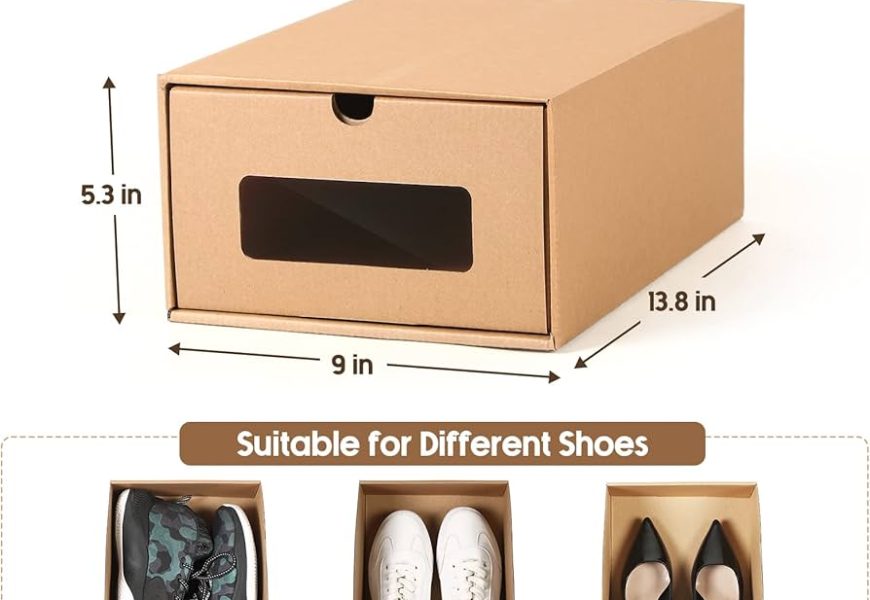In the case of purchasing shoes, people normally forget the packaged box, although very much crucial for protection, transportation, and presentation of shoes. Whether you are a producer or retailer or a customer, the size of the shoe box is necessary for packaging efficiency as well as for the safety of the shoes inside. Those are the dimensions established through various factors such as type, size, and sometimes marketing strategies surrounding the shoe. In this article, we will discuss the standard shoe box size, its average dimensions in centimeters (cm), and the considerations involved in determining the right box size for your shoes.
The Importance of Shoe Box Dimensions
This shoe box does not only serve for pure functionality. It is structured to protect the shoe from all forms of exterior surroundings such as dust, moisture, and damage while shipping or placed in a show room. The secondary function of the shoe box serves as a branding and marketing tool. Through logos, graphics, and other design elements, a shoe’s identity is often tied up with its box. Therefore, the amount of the box has to be balanced between fitting securely the shoes and having space to allow the branding elements to be fronted.
These shoe boxes come in a variety of different sizes depending upon the type or brand of the shoe, but the end result remains the same: safety and presentation of the shoes while providing a suitable box for packaging.
Average Shoe Box Size
Generally, the average shoe box is designed using typical measurements for a pair of adult-sized shoes, ranging from sizes 6 through 12 (U.S. shoe sizes). More often than not, most standard types of footwear-dress shoes, sneakers, and loafers-to name a few-would usually fit into standard dimensions without hanging off or being a tad too tight in an otherwise roomy shoe box.
Standard Shoe Box Size in cm
Although the standard shoe box size varies with the brand of shoes and even style, all the above mentioned dimefnsions are general standard of most shoe retailers. The sheo box dimensions in centimeters for standard adult-sized shoes come in a general range of 30 to 35 cm in length, 18 to 22 cm in width, and 10 to 14 cm in height. Discover the standard shoe box size and its average dimensions in cm. Learn how shoe type, size, and brand impact box packaging, ensuring safety, presentation, and sustainability.
Box types with their size standards
Kids’ Shoe Box: The kids’ shoe boxes are usually small in size. They are for small-sized shoes and usually have the following dimensions:
Length: 25 cm to 30 cm
Width: 15 cm to 20 cm
Height: 10 cm to 12 cm
These measurements ensure a good fit, protecting the shoes from damage and not leaving too much empty space within the box. This prevents the shoes from moving around inside the container.
Women’s Shoe Boxes
Because women’s shoes often range from the flat design to heels and boots, they may require slightly bigger or slightly differently dimensioned boxes. A standard shoe box designed for women might have the following dimensions:
Length: 30 cm to 33 cm
Width: 19 cm to 22 cm
Height: 12 cm to 14 cm
Hoes for high-heeled shoes may be taller, as these leave more height for the heel. Boxes for flats may more compact.
Men’s Shoe Boxes
Men’s shoes, especially in larger sizes, require more ample boxes. A general men’s shoe box may take on such dimensions:
Length: 33 cm to 35 cm
Width: 20 cm to 23 cm
Height: 12 cm to 14 cm
For heavier shoes, however, such as boots, the box height may be increased to ensure ample space for the shoes inside without causing any collision in the transportation process.
Custom Shoe Box Sizes
Many high-end or luxury shoe brands use custom shoe box sizes to give a much better presentation for the product. These boxes can be designed to fit specific dimensions of premium shoes or provide extra space for accessories such as dust bags, care instructions, or shoehorns. Custom boxes can also be of better quality material-including thicker cardboard or even luxury finishes like velvet or magnetic closings.
Factors That Influence Shoe Box Size
The Role of Shoe Box Dimensions in Retail
The size of a shoe box also plays a cru Several factors will contribute to determining the size of a shoe box. Among these factors are the type of shoe, the shoe’s size, and even aesthetic preferences. Here are some of the key considerations:
Shoe Type and Style
The size of the shoe often determines the size of the box. For instance, high heeled or boots require bigger boxes and perhaps the versatile types, which include sandals or ballet flats, can be accommodated in smaller boxes. More elaborate designs on shoes may require more space, as these pieces may cause damage.
Shoe Size
As the shoe sizes increase, so do the dimensions of the box to be used. For instance, shoes that are of size 13 and above in men or size 10 in women need a longer and wider box to be accommodated correctly.
Protection Requirements
Different kinds of protection are also needed for shoes. Luxury, for instance, and other delicate shoes might come in special boxes that have extra padding, so the box is usually a bit larger than your common model.
Brand and Aesthetics
Other brands are concerned with the design of their packaging. The length and width of the shoe box are then decided upon, not only for the shoe but for the dramatic visual moment of unboxing.
Environmental Factor
Due to the growing concern over sustainability, most brands are now choosing such materials that offer eco-friendliness, and efficient designs are used in the boxes. Standard sizes of boxes reduce wastage and minimize the amount of packaging material.
How to Measure Your Shoe Box
In case you ever want to measure the dimensions of a shoe box for your purposes, it is worth establishing an external measurement where you will consider the shoe box length, width, and height, whether the lid or flaps are included. Here’s a step-by-step guide on how to measure a shoe box.
Length
Width
Height
Measuring your box correctly will give you an accurate understanding of the space inside, which is particularly important when shoe types vary.
Conclusion
The standard size of shoe box and the average in centimeters is essential in choosing the appropriate packaging for shoes. Whether you’re a consumer, retailer, or manufacturer, understanding these dimensions ensures that shoes remain protected during shipping, storage, and display while maintaining a pleasing aesthetic. The most common dimensions for adult shoes tend to be around 33 cm in length, 20 cm in width, and 12 cm in height, though variations exist based on shoe size and type.
By choosing the right shoe box dimension, one ensures his shoes are packaged with safety and presented attractively while helping retailers and manufacturers optimize their storages and shipment processes. Sustainability and eco-friendly practices continue to grow in importance; standardized shoe box dimensions also contribute to waste reduction and improvement in efficiency of packaging, hence becoming an important aspect in the overall sustainability efforts of the shoe industry.









